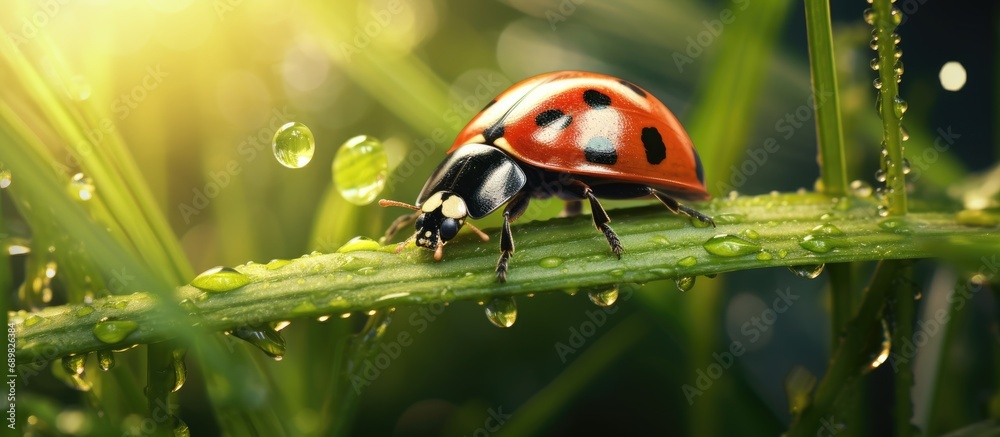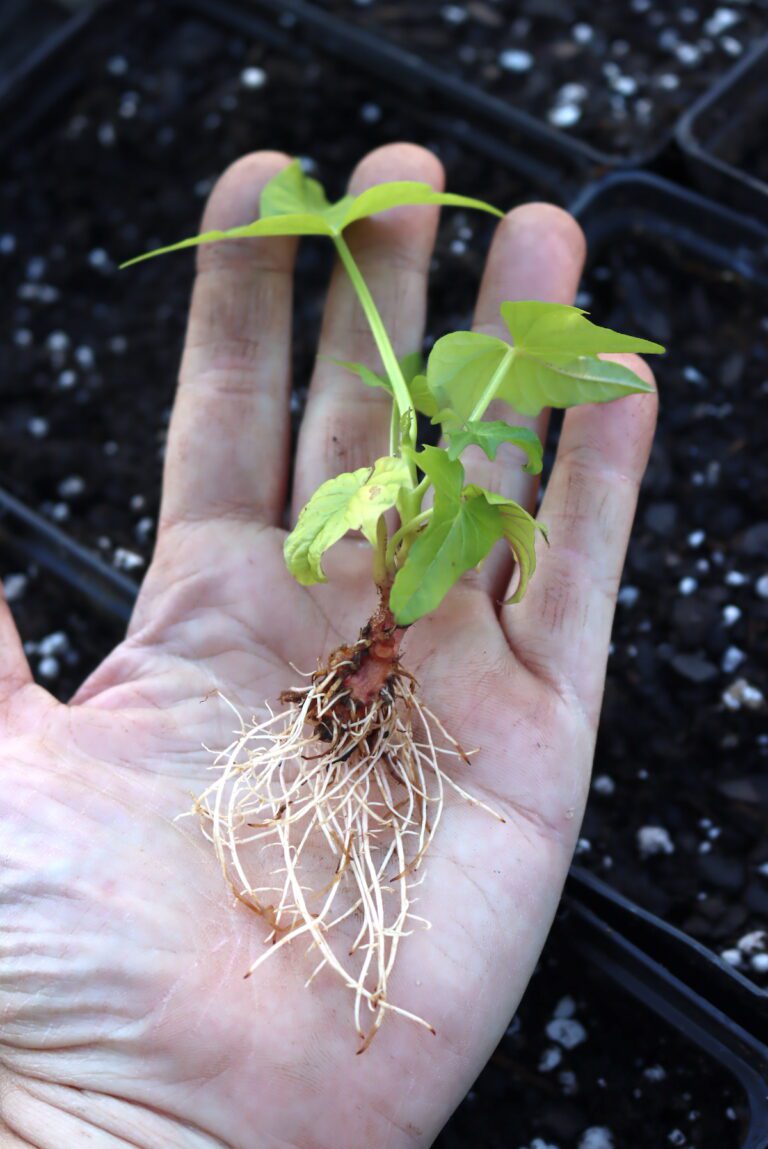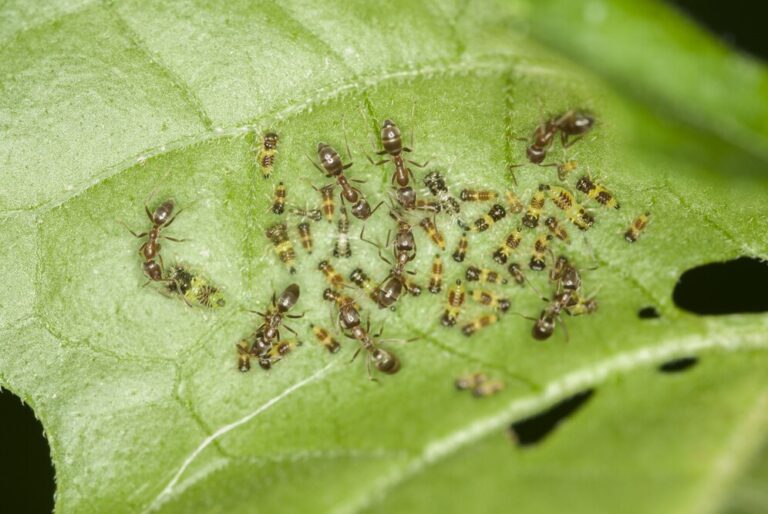How to Identify and Control Different Types of Cucumber Beetles in Your Garden
Table of Contents
Cucumber beetles are one of the most common and destructive pests that can affect cucurbits, such as cucumbers, squash, melons, and pumpkins. These small, yellow, and black beetles can cause serious damage to your plants, both by feeding on them and by spreading a deadly disease called bacterial wilt. Bacterial wilt is caused by a bacterium that lives in the gut of the beetles, and that can infect the plants through the beetles’ saliva. Once infected, the plants wilt and die, usually within a few days or weeks. Bacterial wilt is incurable and can wipe out entire crops and cause significant losses for gardeners and farmers.

Seven types of cucumber beetles affect cucurbits: cucumber beetle, spotted cucumber beetle, striped cucumber beetle, orange cucumber beetle, western spotted cucumber beetle, banded cucumber beetle, and red cucumber beetle. They belong to two genera, Diabrotica and Acalymma, both in the family Chrysomelidae1. They have similar life cycles and behaviors, but they differ in their appearance and geographic distribution. Some of them are more specialized in cucurbits, while others have a broader host range. Some of them are more widespread than others, and some of them are more active at different times of the year.
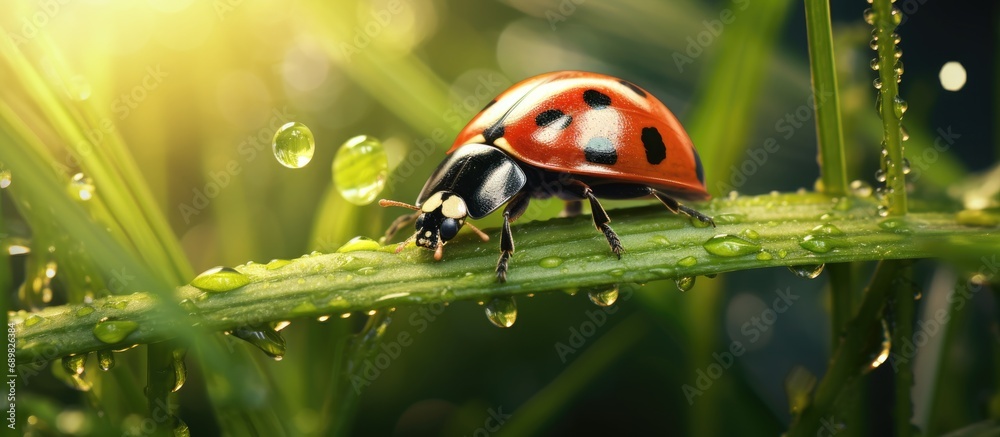
The purpose of this article is to show you how to identify and control different types of cucumber beetles in your garden. You will learn how to recognize the beetles by their shape, size, color, and pattern, and how to distinguish them from other similar-looking beetles. You will also learn how to monitor the beetle activity and damage, and how to use various methods to prevent and reduce the beetle infestation and bacterial wilt disease. By following these tips, you can protect your plants from cucumber beetles and bacterial wilt disease, and enjoy a bountiful harvest of healthy and delicious cucurbits.
How to Identify Different Types of Cucumber Beetles
Cucumber beetles are small, yellow, and black beetles that can cause serious damage to your cucurbits, such as cucumbers, squash, melons, and pumpkins. They can also transmit bacterial wilt disease, which can kill your plants in a matter of days. Therefore, it is important to identify and control these pests as soon as possible.
Seven types of cucumber beetles affect cucurbits: cucumber beetle, spotted cucumber beetle, striped cucumber beetle, orange cucumber beetle, western spotted cucumber beetle, banded cucumber beetle, and red cucumber beetle. They belong to two genera, Diabrotica and Acalymma, both in the family Chrysomelidae1. They have similar life cycles and behaviors, but they differ in their appearance and geographic distribution. Some of them are more specialized in cucurbits, while others have a broader host range. Some of them are more widespread than others, and some of them are more active at different times of the year.
In this section, we will describe the appearance, size, color, and pattern of each type of cucumber beetle, and provide pictures for reference. We will also explain the geographic distribution, host range, and seasonal activity of each type of cucumber beetle, and provide maps for reference. Finally, we will provide tips on how to distinguish different types of cucumber beetles from other similar-looking beetles, such as ladybugs, flea beetles, or potato beetles.
Cucumber Beetle
The cucumber beetle (Diabrotica undecimpunctata howardi) is a yellow beetle with 11 black spots on its back. It is about a quarter of an inch long and has a black head and antennae. It is also known as the southern corn rootworm or the spotted cucumber beetle2.

The cucumber beetle is widely distributed in North America, from Canada to Mexico, and from the Atlantic to the Pacific coast. It can be found in almost all states and provinces, except for Alaska and Hawaii3. It has a broad host range, feeding on not only cucurbits, but also corn, beans, potatoes, tomatoes, and other crops. It is active throughout the year in warmer climates, and from late summer to early winter in colder regions.
Striped Cucumber Beetle
The striped cucumber beetle (Acalymma vittatum) is a yellow beetle with three black stripes along its back. It is about a quarter of an inch long and has a black head and antennae. It is also known as the northern corn rootworm or the western corn rootworm.
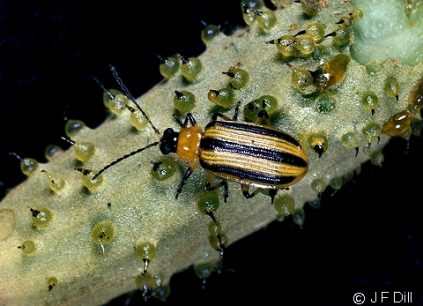
The striped cucumber beetle is more common in the eastern and central regions of North America, where it can be found from spring to fall. It prefers to feed on cucumbers, but it can also attack other cucurbits, such as squash, melons, and pumpkins.
Orange Cucumber Beetle
The orange cucumber beetle (Diabrotica balteata) is an orange beetle with 10 black spots on its back. It is slightly larger than the other types of cucumber beetles, measuring about a third of an inch long. It has a black head and antennae, and black legs.

The orange cucumber beetle is mainly distributed in the southern and western regions of North America, from Texas to California, and from Mexico to Central America. It can also be found in Florida, Hawaii, and the Caribbean. It has a wide host range, feeding on not only cucurbits, but also corn, beans, cotton, peanuts, and other crops. It is active throughout the year in warmer climates, and from late spring to early fall in colder regions.
Western Spotted Cucumber Beetle
The western spotted cucumber beetle (Diabrotica undecimpunctata undecimpunctata) is a yellow beetle with 12 black spots on its back. It is about a third of an inch long and has a black head and antennae. It is also known as the western corn rootworm or the twelve-spotted cucumber beetle.

The western spotted cucumber beetle is mainly distributed in the western and northern regions of North America, from British Columbia to California, and from Montana to New Mexico. It can also be found in Hawaii and some parts of Mexico. It has a broad host range, feeding on not only cucurbits, but also corn, beans, alfalfa, clover, and other crops. It is active throughout the year in warmer climates, and from late summer to early winter in colder regions.
Banded Cucumber Beetle
The banded cucumber beetle (Diabrotica balteata lecontei) is a yellow beetle with two black bands on its back. It is about a quarter of an inch long and has a black head and antennae. It is also known as the banded corn rootworm or the banded cucumber beetle.
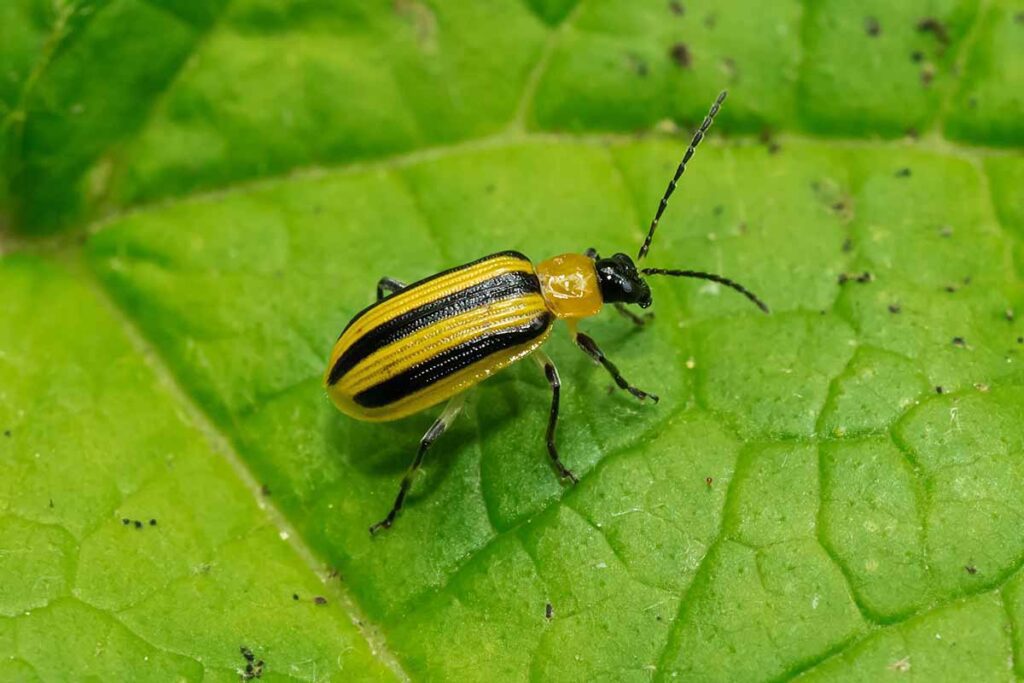
The banded cucumber beetle is mainly distributed in the southeastern and southwestern regions of North America, from Florida to Texas, and from Arizona to California. It can also be found in Mexico and Central America. It has a wide host range, feeding on not only cucurbits, but also corn, beans, cotton, peanuts, and other crops. It is active throughout the year in warmer climates, and from late spring to early fall in colder regions.
Red Cucumber Beetle
The red cucumber beetle (Diabrotica barberi) is a red beetle with four black spots on its back. It is about a quarter of an inch long and has a black head and antennae. It is also known as the red corn rootworm or the red cucumber beetle.
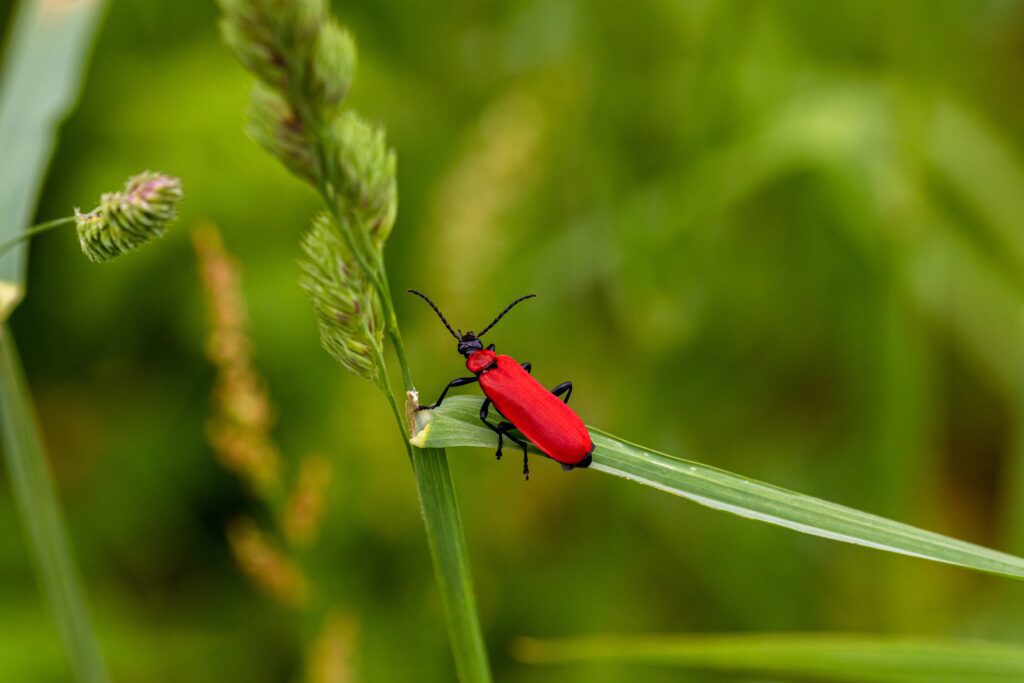
The red cucumber beetle is mainly distributed in the central and eastern regions of North America, from Manitoba to Texas, and from Colorado to Ohio. It can also be found in some parts of Mexico. It has a narrow host range, feeding mainly on corn and cucurbits. It is active from spring to fall.
How to Distinguish Different Types of Cucumber Beetles from Other Similar-Looking Beetles
Cucumber beetles can be confused with other similar-looking beetles, such as ladybugs, flea beetles, or potato beetles. However, there are some ways to distinguish them based on their shape, size, color, and pattern.
- Ladybugs are rounder and more convex than cucumber beetles and have a wider range of colors and patterns. Some ladybugs are yellow and black, but they usually have fewer and larger spots than cucumber beetles. Ladybugs are also beneficial insects that feed on aphids and other pests, while cucumber beetles are harmful insects that feed on plants.
- Flea beetles are smaller and more oval than cucumber beetles and have enlarged hind legs that enable them to jump. Some flea beetles are yellow and black, but they usually have a solid color or a single stripe on their back. Flea beetles are also pests that feed on various plants, but they prefer cruciferous crops, such as cabbage, broccoli, and kale.
- Potato beetles are larger and more elongated than cucumber beetles and have a humpbacked appearance. Some potato beetles are yellow and black, but they usually have 10 stripes on their back. Potato beetles are also pests that feed on various plants, but they prefer solanaceous crops, such as potatoes, tomatoes, and eggplants.
By paying attention to these differences, you can identify different types of cucumber beetles and other similar-looking beetles in your garden.How to Control Different Types of Cucumber Beetles
Prevention
The first principle of cucumber beetle control is prevention. Prevention means taking measures to avoid or reduce the risk of cucumber beetle infestation and bacterial wilt disease in your garden. Prevention is the most effective and economical way of cucumber beetle control, as it can save you time, money, and resources in the long run. Prevention can be achieved by using the following methods:
- Crop rotation: Crop rotation means planting different crops in the same area in different seasons or years. Crop rotation can help prevent cucumber beetles and bacterial wilt disease by breaking the life cycle of the beetles and the bacteria, and by reducing the availability of their preferred food source. For example, you can plant cucurbits in one area for one year, and then plant a non-host crop, such as wheat, oats, or rye, in the same area for the next year. This way, you can starve the beetles and the bacteria, and reduce their population and activity.
- Transplants: Transplants are plants that are grown in a separate location, such as a greenhouse, a nursery, or a container, and then moved to the garden when they are ready. Transplants can help prevent cucumber beetles and bacterial wilt disease by giving the plants a head start and a competitive advantage over the beetles and the bacteria. For example, you can start your cucurbits indoors or in a protected area, and then transplant them to the garden when they are strong and established. This way, you can avoid the early and peak season of the beetles and the bacteria, and reduce their damage and transmission.
- Floating row covers: Floating row covers are thin and lightweight fabrics that you can use to cover your plants and protect them from pests, diseases, and weather. Floating row covers can help prevent cucumber beetles and bacterial wilt disease by excluding the beetles from your plants, and by creating a physical barrier between the plants and the beetles. For example, you can use floating row covers to cover your cucurbits right after planting or transplanting, and secure them at the base.

Monitoring
Monitoring is the process of checking the presence and activity of cucumber beetles in your garden and assessing the level of damage and disease they cause. Monitoring is important for determining the need and timing of intervention and evaluating the effectiveness of your control methods.
To monitor cucumber beetles, you should inspect your plants regularly, at least once a week, or more often if the beetle pressure is high. You should look for the beetles themselves, their eggs, their larvae, their feces, and their damage on the leaves, stems, flowers, and fruits of your plants. You should also look for signs of bacterial wilt disease, such as wilting, yellowing, and dying of the plants.
You can use various tools and techniques to monitor cucumber beetles, such as:
- Visual observation: You can use your eyes or a magnifying glass to look for the beetles and their damage to your plants. You can also use a smartphone camera to take pictures and zoom in on the details. You should inspect your plants in the morning or evening when the beetles are most active and visible.
- Traps: You can use traps to capture and count the beetles in your garden. You can use yellow sticky traps, which are yellow cards or boards coated with a sticky substance that attracts and traps the beetles. You can also use yellow cup traps, which are yellow plastic cups filled with water or oil that lure and drown the beetles. You should place the traps near the plants, off the ground, and check them regularly.
- Lures: You can use lures to attract and identify the beetles in your garden. You can use floral lures, which are synthetic compounds that mimic the scent of the flowers of the cucurbits. You can also use pheromone lures, which are synthetic compounds that mimic the sex hormones of the beetles. You can combine the lures with the traps, or use them separately, and observe the response of the beetles.
By monitoring cucumber beetles, you can get a better understanding of the beetle population and activity in your garden, and decide the best course of action to control them.
Intervention
Intervention is the process of applying various methods to prevent and reduce the damage and disease caused by cucumber beetles in your garden. Intervention is necessary when the beetle pressure is high, and the damage and disease are severe or threatening.
To intervene cucumber beetles, you can use various methods, such as:
Cultural methods:
Cultural methods are methods that involve modifying the environment or the practices of your garden to make it less favorable or accessible to the beetles. For example, you can use crop rotation, which is changing the location or the type of your crops every year, to disrupt the life cycle and the host preference of the beetles. You can also use intercropping, which is planting different crops together, to confuse and repel the beetles. You can also use sanitation, which is removing and destroying the infested plants and debris, to eliminate the sources and the shelters of the beetles.
Cultural methods are generally effective, safe, cheap, and easy to implement. They can work for all types of cucumber beetles, as they reduce their food and habitat options. However, cultural methods may not be enough to control severe infestations, and they may require more planning and labor than other methods. They may also affect the yield and quality of your crops, depending on the crops you choose and the timing of your planting and harvesting.
what you can do
- Rotate your cucurbits with non-host crops, such as grains, legumes, or brassicas, to reduce the beetle population and disease transmission.
- Intercrop your cucurbits with repellent plants, such as radishes, marigolds, or garlic, to deter the beetles from feeding and laying eggs.
- Remove and burn the infested plants and debris at the end of the season, to prevent the beetles from overwintering and emerging in the spring.
Mechanical methods:
Okay, I will try to expand on the mechanical methods for controlling each type of cucumber beetle in more detail. Here is a possible expansion:
Mechanical methods are methods that involve using physical barriers or devices to exclude or remove the beetles from your garden. These methods can be effective, safe, cheap, and easy to implement, but they may also require more time and effort than other methods, and they may affect the pollination and growth of your plants, depending on the type and timing of your covering and removal. You can use row covers, hand-picking, vacuuming, or traps to control all types of cucumber beetles.
Row covers are thin and lightweight fabrics that cover your plants and protect them from beetles. They work by preventing the beetles from landing on and accessing your plants, thus reducing their feeding and egg-laying. You can use row covers from the time of planting until the time of flowering when the plants need pollination. You should remove the covers during the day, when the pollinators are active, and put them back at night when the beetles are more active. You should also secure the edges of the covers with soil or weights, to prevent the beetles from crawling under them. Row covers are especially useful for young and vulnerable plants, such as seedlings and transplants.
Watch this video to learn more!
Handpicking and vacuuming are methods of manually collecting and killing the beetles from your plants. They work by reducing the beetle population and the disease transmission. You can use hand picking or vacuuming to remove the beetles from your plants, especially in the morning or evening, when the beetles are less active and more visible. You should wear gloves and use a bucket of soapy water to dispose of the beetles, as they may bite or secrete a foul-smelling substance when disturbed. You can also use a handheld or a backpack vacuum to suck up the beetles from your plants, and then empty the vacuum bag into a bucket of soapy water. Hand-picking and vacuuming are most effective when the beetle infestation is low or moderate, and when you can inspect your plants regularly and thoroughly.
Traps are devices that capture and kill the beetles in your garden. They work by attracting the beetles by their color or scent and then trapping them with a sticky or liquid substance. You can use yellow sticky traps or yellow cup traps to capture and kill the beetles in your garden. Yellow sticky traps are yellow cards or boards coated with a sticky substance that attracts and traps the beetles. Yellow cup traps are yellow plastic cups filled with water or oil that lure and drown the beetles. You should place the traps near the plants, off the ground, and check them regularly. You should also change the traps when they are full or dirty, and dispose of the trapped beetles properly. Traps are most effective when the beetle infestation is low or moderate, and when you use them in combination with other methods, such as lures or insecticides.
Biological methods:
Biological methods are methods that involve using natural enemies or agents to kill or suppress the beetles in your garden. These methods can be effective, safe, and environmentally friendly, but they may also be slow, unpredictable, and variable, depending on the availability and performance of the biological agents. You can use predators, parasitoids, pathogens, or nematodes to control different types of cucumber beetles.
Predators are animals that feed on the beetles, such as ladybugs, lacewings, soldier beetles, ground beetles, spiders, or birds. They can reduce the beetle population and disease transmission by consuming the beetles at different life stages. You can attract or introduce predators to your garden by providing them with food, water, shelter, and plants that they prefer. You can also avoid using insecticides that may harm the predators.
Parasitoids are insects that lay their eggs inside the beetles, and their larvae consume and kill the beetles, such as braconid wasps or tachinid flies. They can reduce the beetle population and disease transmission by parasitizing the beetles at different life stages. You can attract or introduce parasitoids to your garden by providing them with food, water, shelter, and plants that they prefer. You can also avoid using insecticides that may harm the parasitoids.
Pathogens are microorganisms that infect and kill the beetles, such as Bacillus thuringiensis or Beauveria bassiana. They can reduce the beetle population and disease transmission by causing diseases in the beetles at different life stages. You can apply or introduce pathogens to your garden by spraying or inoculating them on your plants or soil. You can also avoid using insecticides that may interfere with the pathogens.
Nematodes are microscopic worms that enter and kill the beetles, such as Steinernema carpocapsae or Heterorhabditis bacteriophora. They can reduce the beetle population and disease transmission by attacking the beetles at different life stages. You can apply or introduce nematodes to your garden by spraying or injecting them into your plants or soil. You can also avoid using insecticides that may affect the nematodes.
what you can do:
- You can use ladybugs, lacewings, soldier beetles, ground beetles, spiders, or birds to prey on the beetles in your garden.
- You can also use braconid wasps or tachinid flies to parasitize the beetles in your garden.
- You can also use Bacillus thuringiensis or Beauveria bassiana to infect the beetles in your garden.
- You can also use Steinernema carpocapsae or Heterorhabditis bacteriophora to kill the beetles in your garden.
By intervening cucumber beetles, you can prevent and reduce the damage and disease caused by them in your garden, and protect your plants and your harvest.
Chemical Methods
Chemical methods are methods that involve using synthetic or natural substances to kill or repel the beetles in your garden. These methods can be effective and fast, but they may also be harmful to the environment, the beneficial insects, and human health, depending on the type and amount of the substances used. You can use insecticides, repellents, or systemic insecticides to control different types of beetles.
Insecticides are chemicals that have insecticidal properties, meaning that they can kill insects by affecting their nervous system, respiratory system, or digestive system. You can apply insecticides to your plants or soil by spraying, dusting, or granulating them. You can use insecticides to control all types of beetles, as they can kill the beetles at different life stages. However, you should use insecticides with caution, as they can also kill beneficial insects, such as pollinators and predators, and they can leave residues on your plants and soil that may affect your health and the environment. You should also follow the label instructions and the safety precautions when using insecticides, and avoid applying them when the plants are in bloom or when the wind is strong.
Repellents are chemicals that have repellent properties, meaning that they can deter insects from approaching or feeding on your plants by affecting their sense of smell or taste. You can apply repellents to your plants or soil by spraying, dusting, or granulating them. You can use repellents to control some types of beetles, such as cucumber beetles, as they can reduce their feeding and egg-laying. However, repellents may not be very effective, as they can wear off over time or be washed away by rain, and they may not prevent the beetles from transmitting diseases to your plants. You should also follow the label instructions and the safety precautions when using repellents, and avoid applying them when the plants are in bloom or when the wind is strong.
Systemic insecticides are chemicals that have systemic properties, meaning that they can be absorbed by plants and distributed throughout their tissues, making them toxic to the insects that feed on them. You can apply systemic insecticides to your plants or soil by spraying, drenching, or injecting them. You can use systemic insecticides to control some types of beetles, such as striped cucumber beetles, as they can kill the beetles and prevent disease transmission. However, systemic insecticides may also be harmful to beneficial insects, such as pollinators and predators, and they may leave residues on your plants and soil that may affect your health and the environment. You should also follow the label instructions and the safety precautions when using systemic insecticides, and avoid applying them when the plants are in bloom or when the wind is strong.
what you can do
- You can use carbaryl, permethrin, or spinosad to kill the beetles in your garden.
- You can also use neem oil, pyrethrum, or garlic spray to repel the beetles in your garden.
- You can also use imidacloprid or thiamethoxam to make your plants toxic to the beetles in your garden.
comparing different methods of cucumber beetle control
| Method | Pros | Cons | Recommendations |
|---|---|---|---|
| Cultural | – Effective, safe, cheap, and easy to implement. – Reduce the beetle population and the disease transmission by disrupting their life cycle and host preference. – Use crop rotation, intercropping, and sanitation. | – May not be enough to control severe infestations. – May require more planning and labor than other methods. – May affect the yield and quality of your crops, depending on the crops you choose and the timing of your planting and harvesting. | – Use cultural methods as a preventive and long-term strategy for all types of cucumber beetles. – Combine cultural methods with other methods, such as mechanical, biological, or chemical methods, for better results. |
| Mechanical | – Effective, safe, cheap, and easy to implement. – Prevent or reduce the beetle access and contact with your plants. – Use row covers, hand picking, vacuuming, or traps. | – May not be enough to control severe infestations. – May require more time and effort than other methods. – May affect the pollination and growth of your plants, depending on the type and timing of your covering and removing. | – Use mechanical methods as a reactive and short-term strategy for all types of cucumber beetles. – Combine mechanical methods with other methods, such as lures or insecticides, for better results. |
| Biological | – Effective, safe, and environmentally friendly. – Kill or suppress the beetles by using their natural enemies or agents. – Use predators, parasitoids, pathogens, or nematodes. | – May be slow, unpredictable, and variable, depending on the availability and performance of the biological agents. – May be affected by environmental conditions, such as temperature, humidity, or rainfall. – May be difficult to obtain, store, or apply biological agents. | – Use biological methods as a complementary and alternative strategy for some types of cucumber beetles, especially striped cucumber beetles. – Combine biological methods with other methods, such as cultural or mechanical methods, for better results. |
| Chemical | – Effective and fast. – Kill or repel the beetles by using synthetic or natural substances. – Use insecticides, repellents, or systemic insecticides. | – May be slow, unpredictable, and variable, depending on the availability and performance of the biological agents. – May be affected by the environmental conditions, such as temperature, humidity, or rainfall. – May be difficult to obtain, store, or apply biological agents. | – Use chemical methods as a last resort and emergency strategy for some types of cucumber beetles, especially cucumber beetles and spotted cucumber beetles. – Use chemical methods with caution, and follow the label instructions and the safety precautions. – Use selective and low-toxicity substances, such as neem oil, pyrethrum, or spinosad, and avoid broad-spectrum and high-toxicity substances, such as carbaryl, permethrin, or imidacloprid. |
Conclusion
Cucumber beetles are small, yellow, and black beetles that can cause serious damage to your cucumber, such as cucumbers, squash, melons, and pumpkins. They can also transmit bacterial wilt disease, which can kill your plants in a matter of days. Therefore, it is important to identify and control these pests as soon as possible.
Seven types of cucumber beetles affect cucurbits: cucumber beetle, spotted cucumber beetle, striped cucumber beetle, orange cucumber beetle, western spotted cucumber beetle, banded cucumber beetle, and red cucumber beetle. They belong to two genera, Diabrotica and Acalymma, both in the family Chrysomelidae. They have similar life cycles and behaviors, but they differ in their appearance and geographic distribution. Some of them are more specialized in cucurbits, while others have a broader host range. Some of them are more widespread than others, and some of them are more active at different times of the year.
To control these pests, you can use various methods, such as cultural, mechanical, biological, or chemical methods. Each method has its own advantages and disadvantages and may work better for some types of cucumber beetles than others. In this article, we have provided specific methods for each type of cucumber beetle, given examples of products, tools, or techniques that can be used for each method, compared the pros and cons of each method, and given recommendations based on the effectiveness, safety, cost, and availability of each method.
We hope you find this article helpful and informative. If you have any feedback or questions, please feel free to leave a comment below or contact us via email. We would love to hear from you and help you with your gardening problems.
If you liked this article, please subscribe to our blog, follow us on social media, and check out our other related articles on how to grow and care for cucurbits. You will find more tips and tricks on how to deal with pests, diseases, and other challenges in your garden. Thank you for reading and happy gardening!

Kanike Sreekanth, a prolific writer at SouthElMonteHydroponics, brings a unique blend of creativity and scientific rigor to the table. With a degree in Horticulture from a prestigious institution, Kanike’s expertise spans hydroponic farming, plant biology, and agricultural sustainability. Their passion for exploring innovative cultivation methods and promoting environmental stewardship drives them to uncover new insights in the realm of hydroponics. Kanike’s writing serves as a conduit for sharing their knowledge and inspiring others to embrace alternative farming practices for a more sustainable future.

